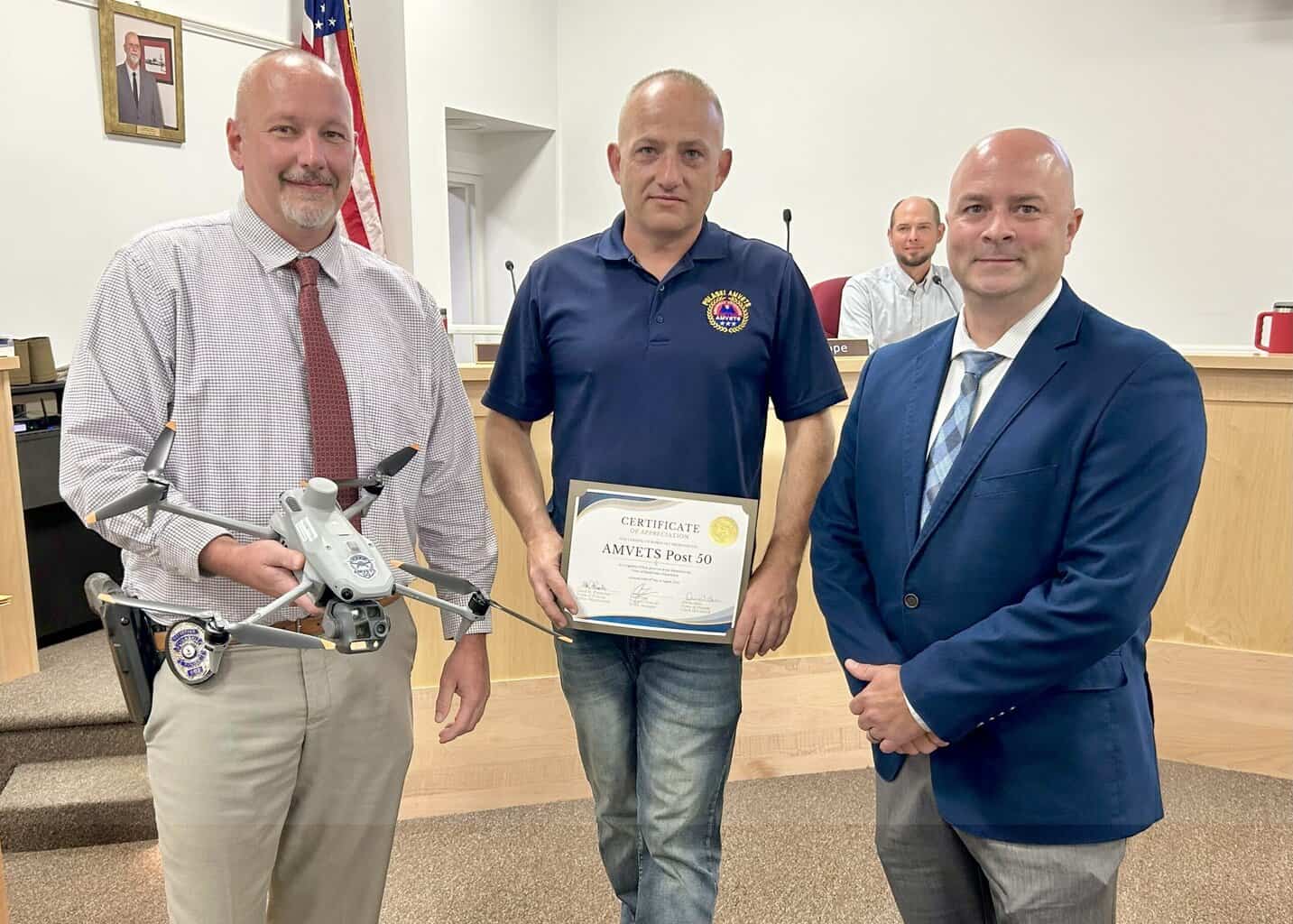Transit system shortfall discussed at Town Council
 William Paine/Patriot Publishing
William Paine/Patriot Publishing
Pulaski Police Chief Michael Parmelee presents Gary Martin Jr. of AMVETS a Certificate of Appreciation on behalf of the Town of Pulaski for donating a drone to the police force. Investigator S. McMillan is the drone pilot for the police force. From left Investigator S. McMillan, Gary Martin Jr of AMVETS and Pulaski Police Chief Michael Parmelee.
By WILLIAM PAINE
Patriot Publishing
Pulaski Town Council on Tuesday heard presentations by agency representatives seeking to maintain or increase monies allocated to them from the general fund.
One of those presentations was from Arron Clark, Project Manager for Virginia’s Department of Rail and Public Transportation (DRPT), gave council a sobering appraisal of Pulaski Area Transit’s financial needs.
Clark mentioned how ridership decreased during the COVID pandemic but that ridership was increasing slowly both in Pulaski and statewide. According to Clark, inflation rose by 22 percent since 2019, but the operations costs for transit systems have increased by 45 percent during that same period.
The DRPT manages and provides state funding for transit systems throughout Virginia and has provided 21 percent of operational costs for Pulaski Area Transit since 2020. The federal government provided nearly half of the operational costs for the bus service in Pulaski over that time period.
Pulaski Area Transit (PAT) requested $101,138 from both the town and the county of Pulaski for its operational needs for fiscal year 2026. The town allocated $75,000 to PAT and the county allocated $95,000 to PAT resulting in a $32,276 shortfall in local funding for the service.
State funds are distributed using a complicated formula and this year Pulaski Area Transit will receive less funding than before. Less state funding combined with less local funding will result in a $52,417 shortfall for Pulaski Area Transit.
Since the federal government operates using a reimbursement formula, less money spent by local and state sources will automatically result in less funding allocated to Pulaski Area Transit through federal sources. According to Clark, this loss of federal funds will result in a shortfall closer to $80,000 or 9 percent of total projected expenses for Pulaski Area Transit.
Cost saving opportunities such as removing underutilized stops, adding more part time employees and reducing service hours are now being considered.
“Service cuts will result in lower levels of service and as you reduce service, you receive less money from the state and less money from the feds,” said Clark. “This can eventually lead to reduced rider satisfaction and less ridership because there’s less service. That cycle tends to turn into a negative feedback loop. Less money now will mean less money later.”
Clark stopped short of asking council to provide more money to Pulaski Area Transit and added that the current leadership of Pulaski Area Transit is doing a great job on a “shoestring budget.”
“We wish we could offer every dollar for anything that we need,” said Vice Mayor Brooks Dawson. “That would be a dream but we have things that we need to do in multiple locations.”
In another presentation, Jennifer Wilsie, Director of Housing for the new River Valley Regional Commission, asked council for a five-year commitment to allocate $15,582 to a housing trust fund.
That figure is based on population with the Town of Pulaski having 8,904 residents as of the last census. The Town of Dublin with its 2,671 residents pays $4,674 into the housing trust fund, whereas the county’s share is $38,493.
In all, Pulaski County and its towns provide $58,749 to the NRV Housing Trust Fund. Floyd, Giles and Montgomery Counties and the City of Radford also add money to the fund annually relative to their populations.
“The concept is a large joint bank account where all the dollars that are put into it are set aside for preservation or development,” said Wilsie. “So, we’re preserving affordable housing when we’re creating new units and that means our dollar sources are coming from everyone in the region, and they’re then awarded on the same basis.”
As Wilsie explained, every five years, one of these localities can draw from the fund to build affordable housing units in their region with Pulaski County receiving $856,000 at each of these intervals. Claremont Elementary School, which is currently being transformed into a 50-unit apartment building at a cost of $850,000 was part of the first round of awards from the housing trust fund.
The Town will continue to allocate money to this housing trust fund for the foreseeable future.
Vera Carter and Connie Patterson came to the podium to ask council to continue funding the Emergency Needs Task Force.
“Founded in 1989 the emergency needs Task Force Pulaski County is an incorporated non-profit charitable organization that shares your mission to serve the residents of Pulaski,” said Patterson. “Our mission is to provide and facilitate emergency assistance to lower income individuals and families of Pulaski who are experiencing a financial crisis.”
“From January 2024 through December 2024, we serviced 1,440 clients for a total of 700 households,” said Carter. “Many lower income individuals and families struggle to meet their basic needs, leading to stress and anxiety. Providing emergency financial assistance eases this burden, promoting overall mental and emotional wellbeing, access to nutritious food and essential utilities directly contributes to better physical health. Financial emergency assistance can prevent homelessness by helping individuals and families keep a roof over their heads. Stable housing is essential for community stability.”
As in past years, the Emergency Needs Task Force will receive $10,000 from the Town’s General Fund.
Ginny Ayers, Executive Director at Literacy NRV and Volunteer Coordinator Brittany Hash requested council provide $968 to their organization. As Ayers explained, Literacy NRV is a community-based literacy organization that teaches basic reading, writing, math, computer skills and English for speakers of other languages.
According to Hash, Literacy NRV served 448 students last year, which is 100 more students than the year before. Of that number, 294 were English language learners and 40 were studying for their G.E.D. This was accomplished through the efforts of 180 volunteers, as Ayers is the only full-time employee of Literacy NRV.
“I’d love to see you asking for more for what you all do,” said Councilman Steven Erickson.
Ayers mentioned how this was a ten percent hike from the previous year’s funding, but agreed to up her request for donation the following year.
Council passed two resolutions at Tuesday’s meeting. The first was for the reappropriation of grants and checking accounts totaling $5,523,500.65. These funds will be carried over into the current fiscal year.
Council also voted to appoint Town Manager Todd Day to the board of directors for the Agency on Aging.
Both resolutions passed unanimously, though Sunshine Cope was absent for Tuesday’s meeting.
The next town council meeting will take place on Tuesday Sept. 2.
A joint Planning Commission/Town Council meeting will take place at 6 pm on Monday, Sept. 8 for the purpose of considering a zoning change for the 177-acre development between Lee Highway and Memorial Drive. Council will vote on whether to change zoning from R1 to R3 at that meeting.
A public hearing regarding property owners adjacent to the 177-acre development is set to take place at the next town council meeting at 7 pm, Tuesday, Sept. 16.
According to Day, six property owners have extended their property lines into the 177-acres set to be transferred to Shah Development to build this new residential neighborhood. Some of these property owners have built structures in the area just beyond their own property lines and the Town is willing to allow some of these property owners to purchase this land, which is currently owned by the town. The 177 acres will be transferred to Shah Development when these property line disputes are settled.
Before the presentations began Tuesday, Chief Michael Parmelee of the Pulaski Police Department presented a certificate of appreciation to Gary Martin Jr. of AMVETS Post 50 for donating a high-tech drone costing nearly $20,000.
According to Parmelee, this drone can be used for watching over police actions, search and rescue missions, finding missing persons and looking for fugitives from the law.

